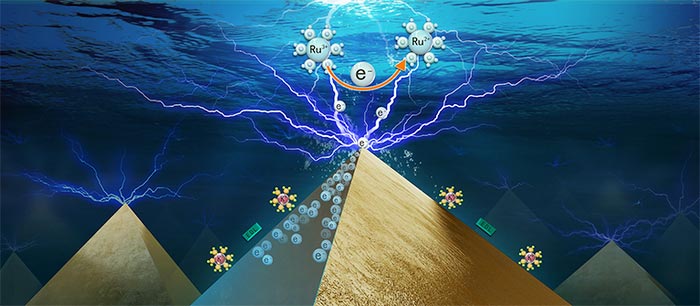Scientists capture electron transfer image in electrocatalysis process

Scientists capture electron transfer image in electrocatalysis process
Credit: DICP
The involvement between electron transfer (ET) and catalytic reaction at electrocatalyst surface makes electrochemical process challenging to understand and control. How to experimentally determine ET process occurring at nanoscale is important to understand the overall electrochemical reaction process at active sites.
Recently, a research group led by Prof. LI Can and Prof. FAN Fengtao from the Dalian Institute of Chemical Physics (DICP) of the Chinese Academy of Sciences (CAS) captured the electron transfer imaging in electrocatalysis process.
This study was published in Nano Letters on Oct. 14.
The researchers established an in-situ electrochemical imaging method with nanoscale spatial resolution, which combined atomic force microscopy and scanning electrochemical imaging. This method can realize the three-dimensional movement of the scanning nanoprobe to map the local distribution of the generated outer-spherical electron transfer molecules and the catalytic product molecules.
The visual electron transfer images on metal nanoplates directly demonstrated that the electron transfer process at nanoscale presented a site-dependent heterogeneity.
Moreover, to decouple the interference of the mass transfer effect on the electron transfer, the researchers conducted a series of elaborate experiments and complex mathematical modeling to extract the rate constant and internal potential difference. They found that the relationship between the interfacial inner potential difference and the rate constant followed a linear fashion.
This work realizes the in-situ observation of electron transfer process and catalytic reaction in the electrochemical reaction, and provides new ideas for the development of in-situ imaging characterization method and the detection of the mechanism of the electrocatalytic reactions.
“This is a new milestone of the scanning electrochemical probe techniques, making it possible to discover the structure-performance relation of nanocatalyst from the bottom of physical and chemical principles,” commented by one of the reviewers.
Journal: Nano Letters
DOI: 10.1021/acs.nanolett.1c03529
Method of Research: Commentary/editorial
Subject of Research: Not applicable
Article Title: Visualizing the Spatial Heterogeneity of Electron Transfer on a Metallic Nanoplate Prism
Article Publication Date: 14-Oct-2021
Media Contact
Jean Wang
Dalian Institute of Chemical Physics, Chinese Academy Sciences
wangyj@dicp.ac.cn
Office: 41182464221
Original Source
All latest news from the category: Life Sciences and Chemistry
Articles and reports from the Life Sciences and chemistry area deal with applied and basic research into modern biology, chemistry and human medicine.
Valuable information can be found on a range of life sciences fields including bacteriology, biochemistry, bionics, bioinformatics, biophysics, biotechnology, genetics, geobotany, human biology, marine biology, microbiology, molecular biology, cellular biology, zoology, bioinorganic chemistry, microchemistry and environmental chemistry.
Newest articles

Recovering phosphorus from sewage sludge ash
Chemical and heat treatment of sewage sludge can recover phosphorus in a process that could help address the problem of diminishing supplies of phosphorus ores. Valuable supplies of phosphorus could…

Efficient, sustainable and cost-effective hybrid energy storage system for modern power grids
EU project HyFlow: Over three years of research, the consortium of the EU project HyFlow has successfully developed a highly efficient, sustainable, and cost-effective hybrid energy storage system (HESS) that…

After 25 years, researchers uncover genetic cause of rare neurological disease
Some families call it a trial of faith. Others just call it a curse. The progressive neurological disease known as spinocerebellar ataxia 4 (SCA4) is a rare condition, but its…





















